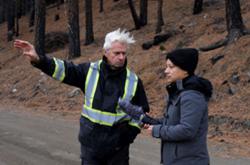
As Barry Milner, the marketing director for GeoTility Systems Corp., explains it, a geothermal system uses the same technology as a refrigerator, taking heat from one place and moving it somewhere else.
"It's a good story," said Milner. Based in Kelowna, with an office in Richmond and one planned for Vancouver Island, Geotility has been installing geothermal heating and cooling systems since 1990. "It is part of the puzzle here of what we need to do."
As building owners and policy makers search for ways to reduce greenhouse gas emissions, companies like Geotility -- which has a new compact drilling platform allowing it to put systems into older buildings that would have been previously difficult to retrofit -- offer a solution.
But as the sector grows, participants and observers agree there's a need for industry standards and for incentives to help make the systems affordable.
"It's not rocket science," Milner said, noting the earliest system he's come across was built in Sweden in 1932. "It's a very simple process of drawing heat from the ground."
Wherever you live, the temperature a few metres below the surface is the same year round. In winter, that heat can be pulled up into a building. In the summer, the system can be reversed to cool the building by pumping heat back into the earth.
The systems use electricity to operate, but for every unit of energy they use they provide four or five units of heat. That efficiency, said Milner, is good for reducing our carbon footprint, improving air quality and decreasing our dependence on fossil fuels.
Awesome efficiency: BCSEA
"The potential there is very great because it's a very efficient source of energy," said Tom Hackney, the policy vice chair for the B.C. Sustainable Energy Association. "In terms of energy efficiency, that's one of the really awesome sources of energy."
The main barrier is cost, but a ground-based heat pump will pay for itself over time, he said. "Upfront costs are a consideration, but if you can get beyond those, it's just a super energy system."
Geotility's most prominent project is likely at the Hotel Georgia in downtown Vancouver. Done while the new hotel tower was under construction, a new compact drilling platform allowed them to work from the lowest level of an already constructed parkade.
It's a system first tested in a downtown Victoria heritage building last year. It means less construction delay in new developments and increases the possibilities for retrofitting buildings, Milner said. And with Vancouver pledging to go carbon neutral by 2020, he said, there may be a lot more retrofitting work to come.
Over 20 years the company has completed projects at the Westjet headquarters in Calgary, Crofton House school in Vancouver, the South Surrey Recreation Centre and many other public and private buildings.
Milner calls Geotility the "largest comprehensive geo-construction firm" in Canada. The company will take a project from design and engineering through installation and servicing. It also owns a utility company, so that in some cases it will maintain ownership of the system while charging consumers for the energy they use as other energy providers would. That way consumers can avoid paying the cost of the system—sometimes a barrier—up front.
Totalling up the greenhouse gas emission reductions on all the projects the company has built, 50,000 tonnes of GHG are avoided annually, Milner said. Over 20 years that works out to a million tonnes of GHG reductions, he said.
Gaining acceptance
The price for a system, in the past, has been a barrier. For a 3,000 square foot building, a geothermal system will cost about $10,000 to $15,000 more than a high-efficiency gas furnace and up-to-date air conditioner, said Milner.
Once it is in, it is cheaper to operate, and will pay for itself in about seven years, he said.
And as energy rates go up, he said, the technology is becoming more competitive and better known. "It's not such a fringe sort of thing."
It's not the cheapest solution, he admitted. "We can't compete with electric baseboards and open the window if you get hot kind of thing." But the company is instead focussed on "quality" developments, ones where a full heating and air conditioning system are part of the attraction.
Customers include a long list of residential developments, many of them towers and projects requiring a more refined heating and cooling system.
And such a system will add to the value of the building, Milner argued. He compared the cost to a granite counter top. "People have to get their heads around is it looks or is it function?" While it might be a wiser investment, he was realistic about the looks-obsessed culture we live in. "We build crap."
The best-suited buildings are schools, hospitals and libraries that are built to be used for 50 years or more. After the seven years a geothermal system takes to pay for itself through energy cost savings, the investment continues to pay off, he said. Still, he added, more people are choosing it for their single family homes.
Standards needed
Geotility is working with the Pacific Carbon Trust so that its systems can be recognized as providing carbon offsets. Even a small household customer who saves five tonnes of greenhouse gas emissions might anticipate a cheque of $125 from the Trust at current rates, Milner said. For bigger buildings the pay-off will be greater.
BCSEA's Hackney said there's a need for the government or a trade organization to set standards in the industry and make sure customers get consistent messages and treatment from contractors. "The industry is a bit in it's infancy now," he said. "These early installations will be the ambassadors for the installations to come."
It might mean registering or certifying contractors, he said.
Milner said his company has been lobbying to have the geothermal industry regulated. "We would like to see stronger guidelines and regulations to ensure customers are protected."
There are many little companies who will put in a system, but with no regulation of the industry it's unclear how many are to standard. "It is scary," said Milner. "I feel for customers who've been put in situations where they've trusted they were making a good investment" only to discover later it wasn't designed or built properly.
The pitfalls are many, he said. "They put crap in. They don't serve them. They don't know what they're doing."
The industry is professionalizing itself and colleges are beginning to offer apprenticeship programs, but government regulation is needed to protect consumers, he said. "I can't stress enough how difficult it is to fix a system that hasn't been designed properly."
He also argued for offering more incentives to help people put systems into older buildings, as well as for other green energy projects.
The billions of dollars B.C. is planning to spend on the Site C hydroelectric project on the Peace River would have a greater impact if it were directed to green technologies like geothermal, wind and tidal energy, he said. "I see great economic opportunities being set back by this major investment in 1950s technology."
Through B.C.'s LiveSmart program the provincial government will give people up to $1,250 to install a ground or water source heat pump certified by the Canadian GeoExchange Coalition. ![]()
Read more: Urban Planning + Architecture

















Tyee Commenting Guidelines
Comments that violate guidelines risk being deleted, and violations may result in a temporary or permanent user ban. Maintain the spirit of good conversation to stay in the discussion.
*Please note The Tyee is not a forum for spreading misinformation about COVID-19, denying its existence or minimizing its risk to public health.
Do:
Do not: